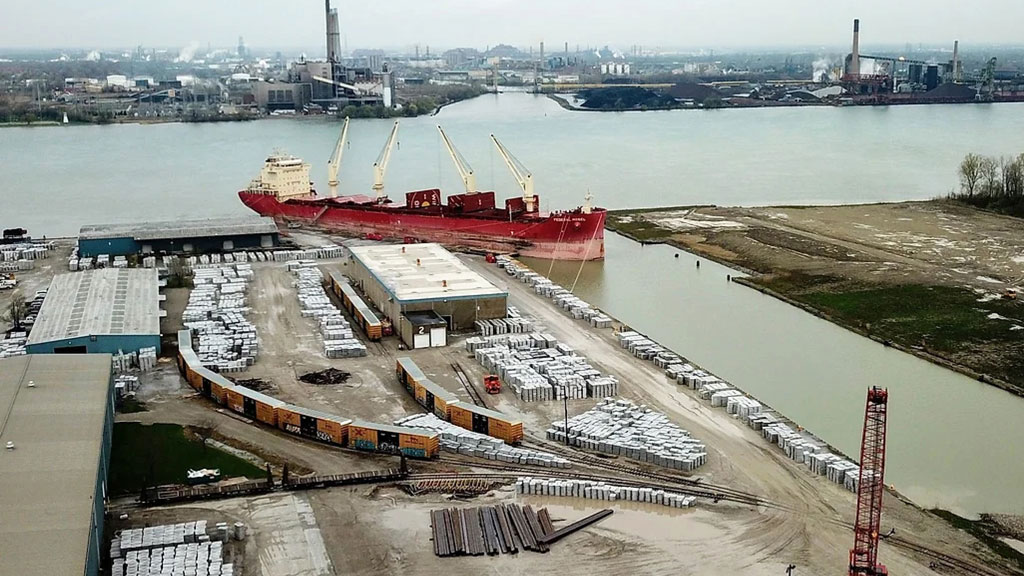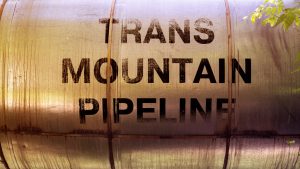Preparations are getting underway for a massive cargo terminal infrastructure expansion and shoreline protection project at the Port of Windsor in southwestern Ontario.
The venture is geared towards shoring up the logistics supply chain and reducing pollution and congestion along Highway 401 leading into the city by shifting the transport of goods from trucks to trains and ships.
The plan is to grow the port and build a new warehouse to allow for the storage of steel used by the automotive industry to make vehicles as well as a multi-modal platform that will provide the Windsor-Essex County region with access to short-sea shipping of containers and expand capacity for moving goods.
“We are at the early steps of moving into project design and engineering design,” explains Steve Salmons, president and CEO of the Windsor Port Authority. “Probably this project will go over two, if not three phases.
“We’ll probably move forward with the warehouse first because it’s the easiest project. That construction will probably be underway by next spring and we hope by the following fall of 2024 we should begin the seawall works. There’s going to be expansion of that wall and reinforcement of another one.”
Presently, the shoreline is rocky with concrete and armour stone. The additional improvements will prevent shoreline erosion and reduce the risk of flooding due to rising lake water levels caused by climate change.
The final part of the project will likely take place in 2025 and include the installation of fencing, lighting, security cameras and hard-topping of surfaces to accommodate the roll-on, roll-off transfer of vehicles directly to and from Windsor.
“We’re hoping this will be all up and running for the 2026 shipping season,” says Salmons. “Until we get down to the design and the reality of the costs, our concepts will be refined. The whole point of this is that it will be a multi-modal facility. We have rail onsite, and truck, and then connected to marine, so all three will be connected.”
The federal government recently announced it was providing $12.5 million to the project from the National Trade Corridors Fund. The funds are going to the Essex Terminal Railway (ETR) Company, which has a sister company, Morterm Limited, that provides a range of material handling and other services at the port.
The project is being initiated because there is a lack of warehousing space in southwestern Ontario and growing recognition that it is more environmentally friendly to move cargo via ships and trains than on highways.
In 2022, 13 terminals at the Port of Windsor moved 5.6 million tonnes of cargo, an increase of 1.35-million metric tonnes or a 32-per-cent increase in comparison to the year before. It was the second largest volume in the port’s history and was only exceeded in the year peak construction took place on the Herb Gray Parkway.
Plans for the warehouse are still being finalized but it will be a climate-controlled, prefabricated steel structure that will enable the storage of steel for the automotive industry. The steel is highly specialized and must be protected from the elements all the time and stored in a humidity-controlled environment.
The project will also enable the port to handle short-sea shipping containers, something that other ports in Hamilton and Cleveland are already doing. A container port is also being built at the Port of Monroe on Lake Erie in Michigan, and Detroit is also looking at constructing a container port as a means to improve the supply chain.
“We see the need, the potential to create the capacity of short-sea shipping in our region and this was our best opportunity,” says Salmons. “This is going to bring Windsor into the short-sea container (business) and give us the competitiveness our local industry needs. If we don’t, we’re going to lose out because everybody around us is doing it.”
More than one million containers come into Ontario every year by rail and truck but it is expensive, clogs the highways and impacts the environment, while transporting goods by water will make the system more efficient and cut carbon emissions dramatically.
Shipping produces 1.2 grams of greenhouse gas emissions for every ton of goods that are transported one kilometre, according to Salmons, but when transported by truck that figure rises to eight grams.
“It’s eight times more greenhouse gases, so shipping is clearly the frontrunner for reducing green-house gases. On top of that, ships are doing all kinds of things in terms of new hull designs and engines to electronic controls that are reducing this even further and there are alternative fuels like biodiesel and propane.”
ETR and Morterm president and CEO Tony De Thomasis notes the funding will allow the port to make improvements to infrastructure and expand operations to ensure Windsor-Essex can access new markets.
“Further investment in our region will bring us even closer to bringing to fruition the multi-modal hub that this area needs — one that supports supply chains, reduces port congestion, creates new jobs, and encourages economic development in sustainable and innovative ways.”









Recent Comments